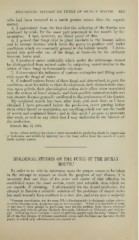Page 809 - My FlipBook
P. 809
BIOLOGICAL STUDIES ON FUNGI OF HUMAN MOUTH. 819
salts had been removed to a much greater extent than the organic
matter.
4. I maintained from the first that the softening of the dentine was
produced by acids for the most part generated in the mouth by fer-
mentation. I had, however, no direct proof of this.
5. I proved that fungi exist in great numbers in the human saliva
and in carious dentine which have the power to produce acid under
conditions which are constantly present in the human mouth. I deter-
mined this acid—for one of the fungi, at least—to be the ordinary
ferment, lactic acid.
6. I produced caries artificially which under the microscope cannot
be distinguished from natural caries by subjecting sound dentine to the
action of these fungi in fermentable solutions.
7. I determined the influence of various antiseptics and filling mate-
rials upon the fungi of caries.
8. I isolated various forms of these fungi and determined, in part, the
conditions most favorable to their development, their characteristic reac-
tion upon gelatin, their physiological action, their effect when inoculated
into the system of lower animals, and their possible connection with cer-
tain obscure diseases generally attributed to the carelessness of the dentist.
My continual search has been after facts, and such facts as I have
obtained I have presented before the profession, never putting before
them either theory or speculation, nor anything which was not the result
of severe and continued labor ; and in this spirit I propose to prosecute
this work, as well as any other that I may undertake in the interest of
the profession.
Berlin, May 21, 1884.
Note.—Since writing the above I have succeeded in producing death by septicfemia
of both mice and rabbits by injecting into the lung saliva from the mouth of a per-
fectly healthy person.
BIOLOGICAL STUDIES ON THE FUNGI OF THE HUMAN
MOUTH/
In order to be able to determine upon the proper course to be taken
in the attempt to remove or check the progress of any disease, it is
necessary that our ideas of the cause and course of that affection be
established upon the most certain, exact, and scientific data which we
are capable of attaining. Unfortunately for the dental profession, the
attempt to furnish a scientific solution of the problems of dental caries
has until recently been confined to a very few, and even now a majority
' German mycologists use the term P'dz indiscriminately to designate either schizo-
mycetes, blastomycetes, hyphomycetes or myxomycetes. When it is desirable to refer
to any one of these groups in particular, they use the prefixes Spall, Sproi^s, Srhimmel
or Fadpn, and Schhiin, giving Sp'iltpih, Sprof^f^pilz, Schimmel- or Fadenpiiz, and Schhim-
pilz. Following their example, I have in previous papers used the term "fungus" for
all of the four groups of mycetes mentioned above, and shall also use the term in this
paper, in which only schizomycetes are treated of.


